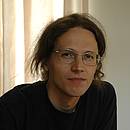The Project
Exploring string field theory – can it explain quantum birth of the universe or properties of elementary particles?
Winner

Dr. Martin Schnabl
Institute of Physics
Academy of Sciences of the Czech Republic
Na Slovance 2
182 21 Prague 8
Czech Republic
Martin Schnabl, 34 year-old Czech scientist, is a member of Princeton’s Institute for Advanced Study. He took his PhD in theoretical physics at the International School for Advanced Studies in Trieste, Italy, then went on to become research associate at the Massachusetts Institute of Technology and CERN fellow at the European Laboratory for Particle Physics. He is an expert on string field theory, a particularly promising approach to string theory. His greatest achievement was the discovery of a solution to the equation governing string fields, one that has remained unsolved for twenty years.
Project Description
Physics at the shortest distances is governed by an as yet uncovered set of laws. Quantum vacuum is a rather complicated and mysterious dynamic object. For miniscule fractions of time, virtual particles fluctuate into their existence only to quickly disappear back into the vacuum. However short their life is, they have a profound and calculable impact on physics.
According to string theory, all observed particles are excitations of an elementary string, whose splitting and joining beautifully and uniquely describe their interactions. String Field Theory, the second-quantized approach to string theory, describes systematically such interactions, including virtual strings appearing and disappearing into the vacuum.
This project aims to develop tools to study both open and closed string field theory; to find and understand their classical solutions and interactions. At the fundamental level one very ambitious goal is to unravel how the dynamics of gravity appearing in the closed string sector can emerge from quantum fluctuations of gauge-theory like open string sector. In the quest for making predictions for the real world physics the project will go two-ways. On the microscopic scale it will explore whether string field theory can be applied to the outstanding and slightly controversial problem of vacuum selection, and thus yield predictions for particle physics. On the cosmological scale it will study possible imprints on the microwave background radiation in the context of popular brane inflation models.

